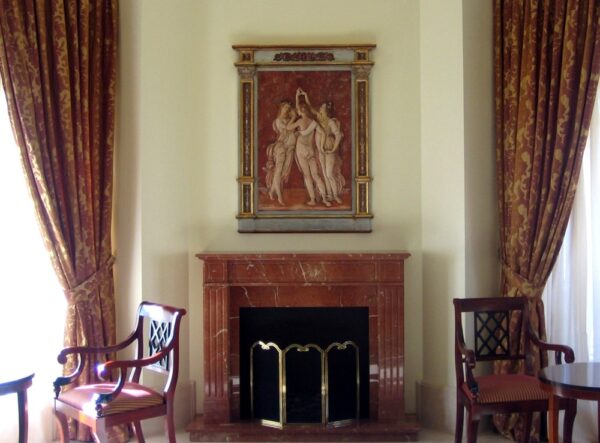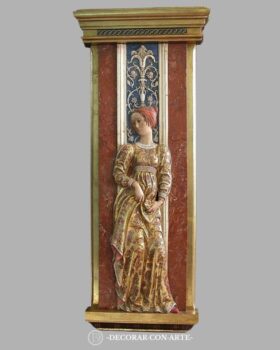Description
The three Graces Bas-relief by Botticelli. Reproduction of a decorative relief made in molded alabaster (alabaster powder with binders). Finished with oil polychrome and aging patinas. Gilded and silvered wooden frame with molded alabaster ornaments and aging patinas.
Measurements: Height: 120 cm. Width: 97 cm. Depth: 7 cm.
Reproductions of reliefs inspired by Renaissance art. Handmade in Spain. Ideal for interior decoration (living rooms, lobbies, libraries, and offices). Not suitable for outdoor use.
The three Graces Bas-relief, inspired by a fragment of Botticelli’s painting “Primavera” (Spring).
For Sandro Botticelli (1445-1510), the visible world was an architecture of rhythmic lines. His own lines and models express unparalleled beauty and delicacy.
This relief is based on the figures of the Three Graces that appear in Botticelli’s famous painting “Primavera.” In this painting, one of the masterpieces of the Italian Renaissance, the goddess Venus is depicted in a forest surrounded by mythological figures: on her left, at the end, the god Mercury with the caduceus is seen, followed by the Three Graces. On the far right, the god of the wind Zephyr can be seen holding the nymph Chloris, who transforms into Flora, who appears to the right of the goddess pouring out flowers.
The Charites or Graces in Greek mythology were a group of three divinities who were part of Aphrodite’s retinue. They are the daughters of Zeus and Eurynome, and were named: Euphrosyne (“joy”), Thalia (“abundance”), and Aglaia (“beauty”). The three Charites or Graces were a favorite subject of visual arts, often represented as three young naked women embracing each other and caressing their faces, sometimes in a dancing attitude.
In Roman mythology, the Graces are known by these names: Castitas (chastity), Pulchritudo (beauty), and Voluptas (desire). There are two interpretations of their symbolism: firstly, in Greek mythology, they would be three aspects of the same attribute; secondly, in Latin mythology, they represent three different archetypes of woman.






















Reviews
There are no reviews yet.